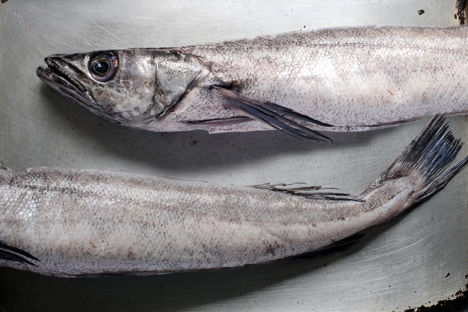They may be from the same family but hake looks distinctly different to cod. Hake are streamlined and fierce with distinctive (and slightly scary) pointed teeth and a silvery belly. Despite its aggressive appearance, the flesh of the hake is a dream – firm, flaky and pale with a subtle flavour that is not dissimilar to cod.
While often overlooked here in the UK, it is a much-loved staple on the continent. Europe’s biggest consumers of hake are Spain – they get through around 6kg per year, per person. Hake can be caught all around the world, but most commonly in the Atlantic and North Pacific from November to March, with the European variety being the most prized.
Typically, hake is sold fresh or frozen but is occasionally sold salted or smoked.
What to look for when buying hake
Hake is noted for its long, slender body and visible front teeth. Only buy fish that are longer than 50cm with bright eyes and red gills. Hake fillets should have firm white flesh with no discolouration, blemishing or bruising.
Avoid buying hake during the breeding season from February to July and check the latest sustainability information to avoid buying fish from depleted stocks.
How to cook hake
Hake is a white fish which is rather grandly referred to as ‘the king of the fish’ by the Spanish. It makes a good alternative choice to other white fish such as cod or haddock. Due to its firm flesh, hake can be prepared in many ways from barbecuing whole to pan-frying the fillets. To check that it is cooked, the delicate flesh should feel firm to the touch and appear opaque. Do not throw away the head and tail – these can be used as a base for a flavoursome fish stock.
How to cook hake whole
When cooking hake whole, ensure that it has been gutted and the gills removed. Roasting is a superb way to cook a whole hake but it can also be barbecued, cooked en papillote or poached. When cooked in the oven, it should be covered with either a tight-fitting lid or wrapped in foil. The flesh of hake absorbs flavours brilliantly so if you’re roasting hake, add a generous amount of flavouring to the cavity and into slashed flesh before cooking to add flavour.
How to cook hake fillets
There are numerous ways to cook hake fillets. Popular options are pan-frying in a little lemon juice and butter, braising with herbs and aromatics or poaching in fish stock, wine and lemon juice. They can be steamed or roasted too. If you have more time, try curing the hake for 1–2 hours in a sugar, salt, citrus and herb mix then cooking en papillote with dill and lemon.
What hake goes with
One of the reasons hake is so popular among chefs and home cooks is that it carries a subtle yet sweet flavour. Hake, like most other white fish, can be paired with flavours as diverse as bacon, horseradish and coconut.
Across the globe, it might be used in an Indian curry and it pairs particularly well with coriander, as a filling for Thai-style fishcakes or even for fish and chips.
Hake is particularly loved in Spain, where it is often grilled or baked and served with chorizo, paprika or garlic. Try Geoffrey Smeddle's Roast hake with chorizo, chickpeas and coriander. In fact, each region in Spain seems to have its own hake dish. In Basque country, it is often partnered with clams; in Galicia with garlic, tomato and onion; in Catalunya, it is often served with potato in a stew. Paul Aussignac pan-fries his hake and serves it with a red pepper relish.
Get in touch
Please sign in or register to send a comment to Great British Chefs.



